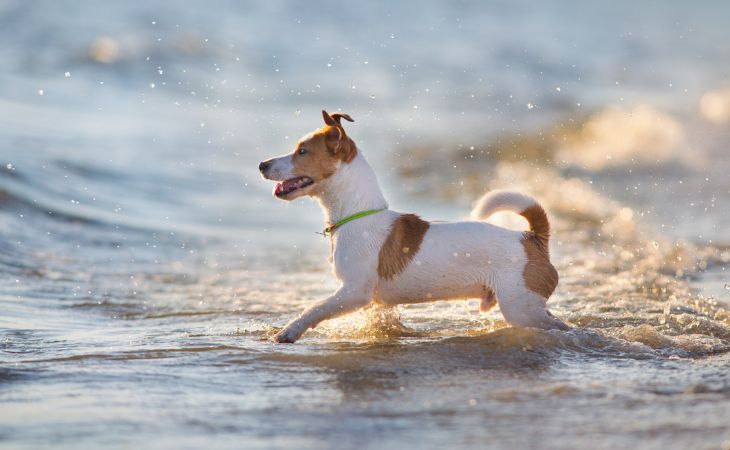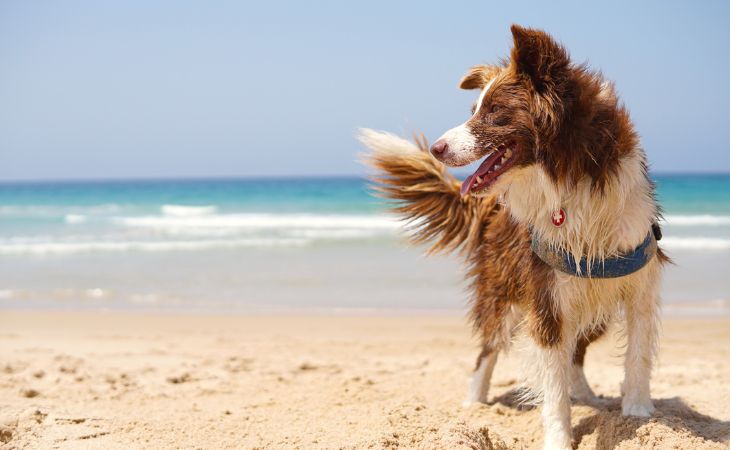Summer is here and that means vacation time! Are you planning on taking your dog to the beach with you this year? While it’s fun to go to the beach, it’s important to keep in mind that there . If you take certain precautions, it will help protect your dog and ensure that you do not spend time at the vet during your vacation.
The accessories that you should take with you
If you are going on vacation with your dog or spending some time at the beach, it’s best to prepare the phone number of the nearest vet. In addition, you should take water and a bowl or recipient with you to keep your dog hydrated.
You should also consider taking a first aid kit with you so that you can intervene quickly in case of small wounds. To keep your dog’s body at a comfortable temperature, you can also consider a cooling vest for your dog.
The rules to respect at the beach
It’s important to keep in mind that not all beaches welcome dogs. Because of this, it’s best to do your research or ask a tourist office about the conditions of access regarding pets.
If you decide to go abroad with your dog, do your research about the laws concerning pets on the beach. Also, do not forget to take your dog’s medical records and any other useful documents with you when leaving for vacation. Like any public space, the owner is responsible for their pet. So you should keep an eye on your dog and make sure that they do not bother other people at the beach.
The sea water: one of the dangers for your dog at the beach
When at the beach, your dog will want to run, play, sniff, and taste so many things. It’s important to make sure that your dog does not ingest too much sea water.
Sea salt poisoning
When your dog arrives at the beach, your dog’s reflex will be to drink the sea water or simply play in the sea water. As this water is very salty, it is possible for dogs to get sea salt poisoning. The signs of poisoning are hyper salivation and digestive issues like diarrhea and vomiting.
Even in small amounts, the salt can have serious consequences on your dog’s organism. In large quantities, it can cause neural disorders and even cause the death of your dog. In case of vomiting or anormal behavior of your dog, you should immediately consult a vet as soon as possible.
Dermatological problems
When your dog is discovering this new play place, they may place their paws in the water. However, contact with the salt in the sea water can cause skin problems for dogs. It can cause irritations, itchiness, and skin infections. The salt can be corrosive on parts of the skin that are already irritated, such as between the toes of their paws, their armpits, and the groin.
Make sure to wash your dog well with running water after leaving the beach to avoid any discomfort or cuts in the skin.
Envenomations by marine animals (jellyfishes, weevers, stingrays)
While it’s not very likely that your dog will encounter a marine animal, it can still happen. If it does, it is important to put on gloves before cleaning the wound to not infect the wound even more.
Then, rinse the wound with fresh water or with salt water if the sting was from a jellyfish. You can then take off the foreign body if there is one. Lastly, disinfect the wound. It is best, in case of envenomation, to ask for advice from a vet.
Drowning
Contrary to what one might think, dogs do not always know how to swim. Even dogs who know how to swim can get tired easily during long swims. It’s, therefore, important to be careful of currents and when your dog starts to get too far from shore. Drowning is a risk to keep in mind. If this happens, ask for help from a paramedic or rescuer or perform first aid procedures if you know how to do them. Then, consult a vet as quickly as possible.

Sand: one of the dangers for your dog at the beach
Sea water is not the only danger for dogs at the beach. There are other dangerous elements for dogs like sand and the objects that we can find in it.
Sea creatures on the beach
Dogs, as curious as they are, can find marine animals on the beach and try to play with them. For this reason, it is important to keep a close eye on them. There is a risk of poisoning if your dog decides to eat everything that they find on the beach. Whatever the marine animal is—crustacean, fish, or bird—do not let your dog eat them or get too close to them.
Seashells and sharp objects
Seashells can hurt your dog’s paw pads or nose like the blade of a razor. When walking around in the sand, it is important to be careful of other sharp objects like pieces of glass or even metal. Even though their paw pads seem tough, it is not enough to protect their paws.
It is important to intervene at the slightest sign of difficulty putting down their paws. You should also inspect their paw pads after leaving the beach, to ensure that there are no cuts.
Ingesting sand
By playing in the sand, notably by picking up objects such as sticks or a ball, your dog will ingest sand. In little doses, sand can irritate your dog’s stomach and cause gastritis. In large doses, sand can cause severe intestinal damage ranging from blockage to bowel obstruction.
Sand in the eyes
When you go to the beach with your dog, your dog will probably scratch at the sand and roll around in it. When they do this, the grains of sand can get stuck in their eyes. This can cause inflammations such as conjunctivitis and corneal ulcers. If your dog scratches at their eyes, if their eyes become red or closed, or if discharge starts to leave their eyes, it’s best to clean them with eye drops for dog.
Then, consult a vet as soon as possible because they are the only ones who can diagnose a corneal ulcer with the help of specific tests. A vet will be able to intervene quickly to avoid irreversible vision problems for your dog.
Fleas, ticks, and worms
Your dog should be dewormed and up-to-date with their flea and tick treatments before going to the beach. Sand can contain fleas as well as worms that can infect your dog. Moreover, fleas carry diseases that can cause serious complications. In addition, worms lead to intestinal problems, such as diarrhea and vomiting.
The temperature of the sand
During certain times of the day, the sand can reach very high temperatures. Even though a dog’s paw pads seem tough, they are actually very sensitive and fragile. The high temperatures of the sand can burn their paw pads. If the sand is too hot, do not hesitate to carry your dog. You can also avoid going to the beach during the hottest parts of the day.

The sun: one of the dangers of the beach
Dogs do not handle heat as well as humans. Depending on how hot it is, your dog will pant more or less to keep themselves cool. With that being said, they sweat a lot less than humans because they have less sweat glands, which makes it more difficult for them to regulate their body temperature.
Heat stroke
If the conditions become extreme and the temperature is high, dogs can get heat stroke. This can weaken the organs of your dog. If your dog gets heat stroke, it’s important to consult a vet as soon as possible. Therefore, it is important to be particularly attentive if your dog shows any of the following signs: heavy panting, excessive drooling, hot head, hot ears, diarrhea, or vomiting.
An umbrella is not enough to protect your dog from the heat at the beach. Instead, it’s best to take your dog to the beach in the morning or at the end of the day. This will allow them to enjoy the beach without the risk of heat stroke.
Every time that you go to the beach, take water and a bowl for your dog to drink in.
Sunburn
To protect your dog from the heat, it’s best to avoid times when the temperature is too hot. This is usually between 12 p.m. and 4 p.m. In addition, before going to the beach, you can protect your dog with a sunscreen that is designed specifically for dogs. You can put it on the parts of their body where they have less fur (near the nose, the stomach). To keep them protected throughout the day, you should reapply the sunscreen every two hours.

